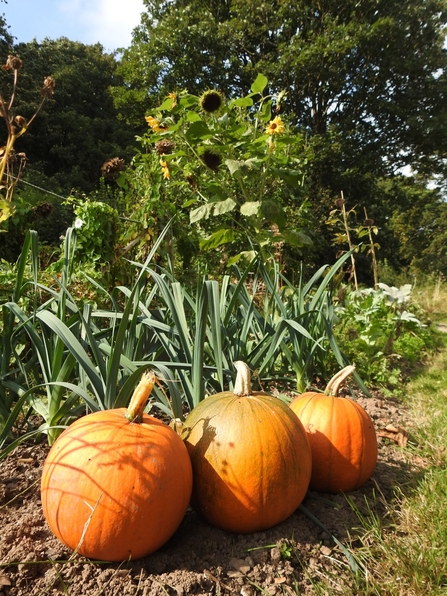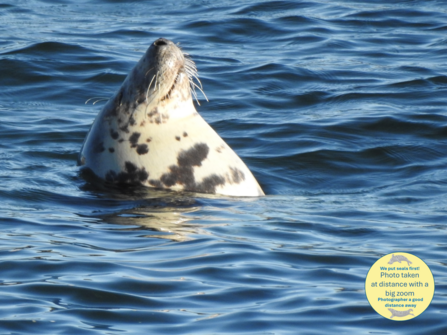So, as we enter autumn and the end of this season’s trips, the island is bountiful with apples, berries, seeds and crispy leaves. It’s a time of year for harvesting from the wildlife friendly veg plots and this year we are pleased with the growth of some cracking looking pumpkins!
An autumnal update from Looe Island Nature Reserve

Pumpkin crop on Looe Island by Claire Lewis
There are also multiple signs that nature is preparing itself for the colder months that lie ahead. We’ll listen out for the piping calls of whimbrels as these long legged birds migrate south for the winter, and watch out for flashes of the white rumps of beautiful wheatears as they too head to warmer climes. The air is filled with the scent of flowering ivy - this plant attracts busily buzzing insects, hungrily filling themselves up with nectar before supplies run out and winter falls over the island.
Then there are the garden spiders – the dew clearly showing their carefully crafted webs. In summer the spiders mate and the females abdomens swell. Around now she’ll lay eggs in a silky cocoon. Once laid the female will not leave the eggs. In guarding the eggs she’ll eventually die of hunger and cold… but if all goes to plan a mass of spiderlings will emerge next spring.
It’s also a time to reflect and report on the visitor season that has passed.
Firstly, thanks to all the recreational water users and commercial operators who have respected wildlife around the island. Giving wildlife space and consideration when encountered on the water and not landing on the island will help wildlife thrive.
Looe Island is part of the Whitsand and Looe Bay Marine Conservation Zone (MCZ) and has a variety of precious wildlife habitats including woodland, maritime, grassland, sand, shingle and rocky reef - visits can only be made on official, organised trips and access by any means (including by foot) is not allowed.
Having said that, this year there have been some very inquisitive young seals who have been approaching and interacting with us humans! Of course if a seal approaches a water user it is on the seal’s terms – you are probably the most interesting thing they’ve seen that day!
To make sure both us humans and seals remain safe, the advice is to stay calm, try to be ‘boring’ so that the seal looses interest and steadily move away. This way these amazingly iconic animals will remain wild and won’t be distracted from their natural routines and more essential behaviour like feeding and resting. If you want to learn more, then there’s lots of fascinating and useful information on the Cornwall Seal Group Research Trust’s website: http://www.cornwallsealgroup.co.uk/

Pudie aka Freckles resting in the sea by Claire Lewis
Now, to some very exciting and unusual bird sightings. Yes, white storks and great white egrets were both seen on the island this summer. Amazing!
The white storks were first reported to us by local birder and regular island volunteer, Derek Spooner. He’d seen them on the mainland and gave us the heads up to look out for them along the coast…. so imagine our delight when a flock of 70 storks used the thermals to gradually glide and swirl right over the island! Further investigations revealed that these birds were part of a rewilding and reintroduction project at Knepp in West Sussex. From the island the birds continued to head further west and would have been exploring their world and building knowledge to guide them towards migrating south for the winter. If you want to learn more check out Derek’s excellent blog on the Looe Marine Conservation Group’s website.

White Storks over Looe Island Cornwall by Adrian Langdon
And the great white egrets? This was a brief but exciting chance encounter with these tall, yellow billed white birds. Clearly not little egrets (seen almost daily on the island’s shores), these large egrets were spotted to the south east of the island and caused the a rapid double take! They promptly flew off towards the south west – we are still waiting to hear if anyone else saw them? Were they also looking for a good southward passage for the winter? Still, a first for the island!

Great white egret ©Derek Moore
This year we’ve continued asking visitors to avoid parts of the main beach, and overall this has been a great success! Birds such as great black-backed gulls, cormorants and oystercatchers have often remained, resting undisturbed for long periods on the island’s shores. There have, of course, still been cases when the birds have been spooked and flown off but they have eventually returned to the beach as they learn that it’s a ‘safe’ area. As well as being a good undisturbed place for the birds, it means more people get to enjoy the sight of plenty of wildlife in a wild place! So again, thank you to everyone who has helped the island’s wildlife to thrive.
Now, as you’d expect we continue to monitor all the island’s wildlife and this includes butterflies and moths. This year hasn’t been the best for insects - we hope it's just a blip due to the poor weather. However, as always in late summer/early autumn, we record large numbers of boldy coloured red admirals – they never seem to let us down! Masses of these butterflies can be seen feeding on sweet smelling flowering ivy. Numbers of red admirals are boosted during the summer by migrants from continental Europe – the thought of which is very impressive - imagine such small and delicate insects making such a long journey! Then, it seems that this species is increasingly over wintering here – meaningly that they are often one of the first and last butterflies spotted each year.
Red admiral on flowering ivy by Claire Lewis
To wrap up, remember that every year public trips to the island end late September/early October. Over the winter the wardens can catch up on lots of maintenance and admin tasks… ready to prepare for re-opening around Easter 2025! Click below to find out how you can visit Looe Island, and find out about our wonderful holiday stays on the island - booking opens in the new year.
Find out more about how you can visit Looe Island here
Claire Lewis
Looe Island Warden’s Assistant
